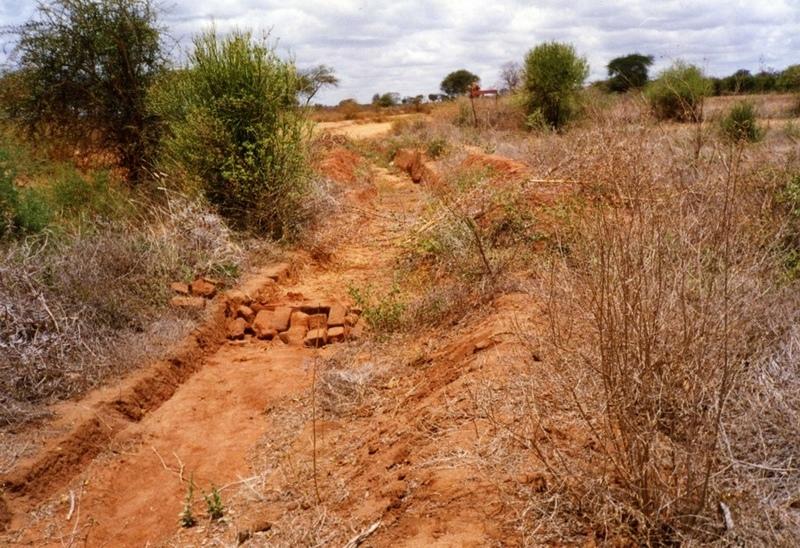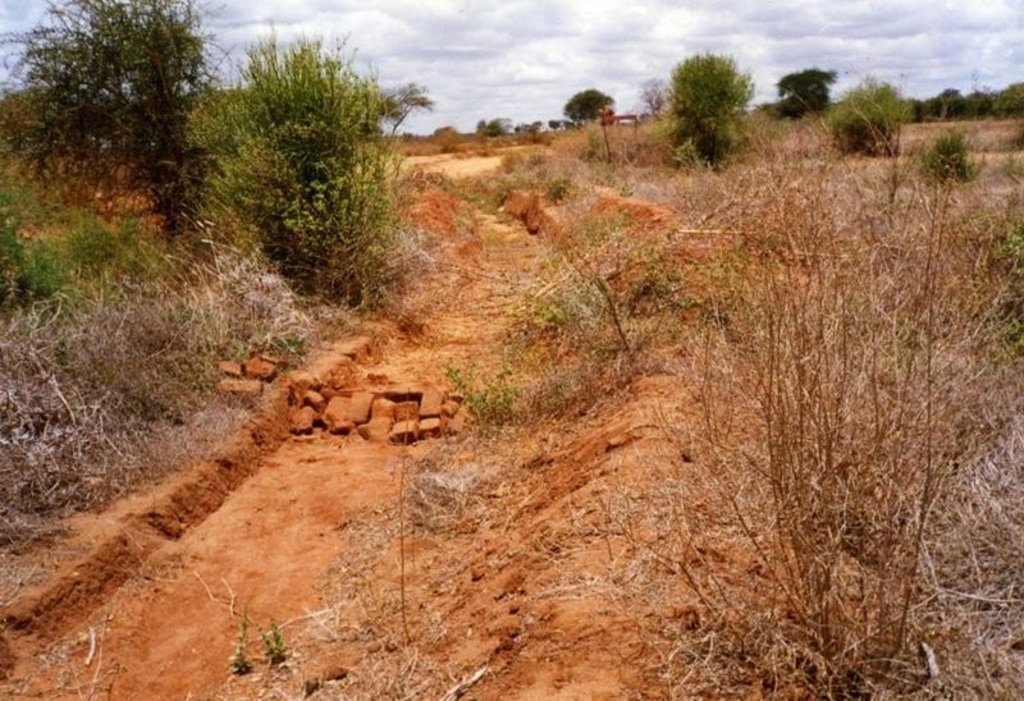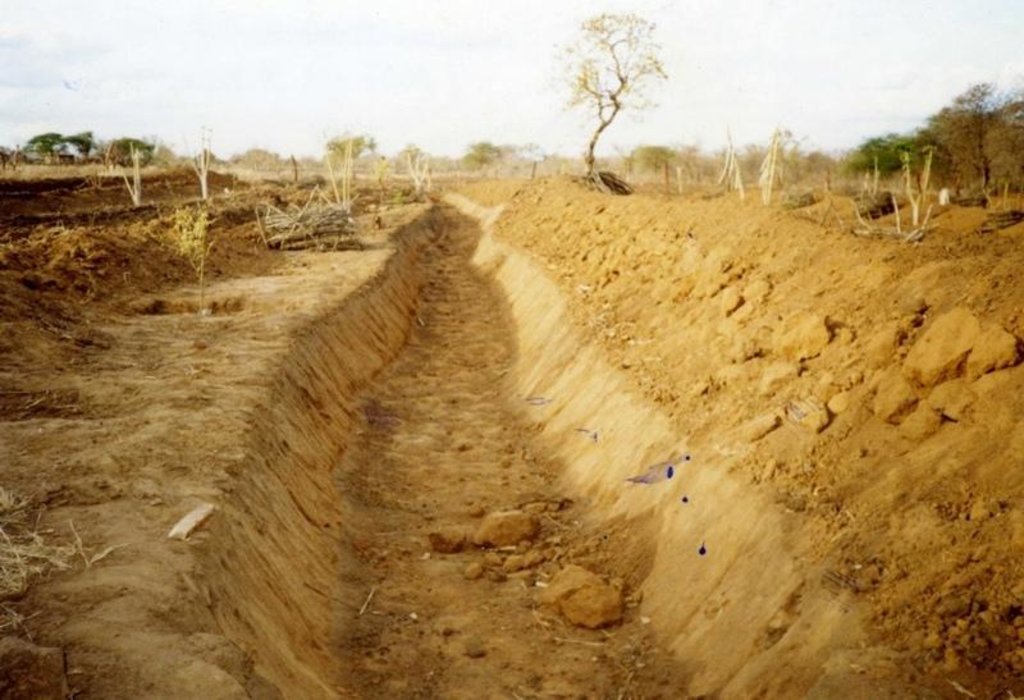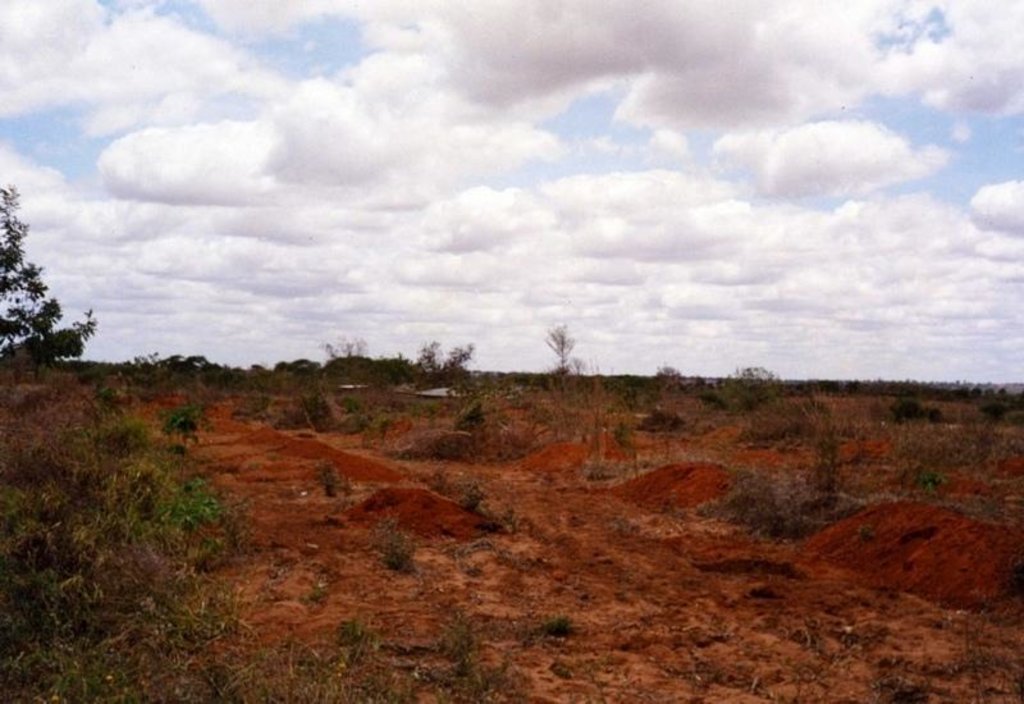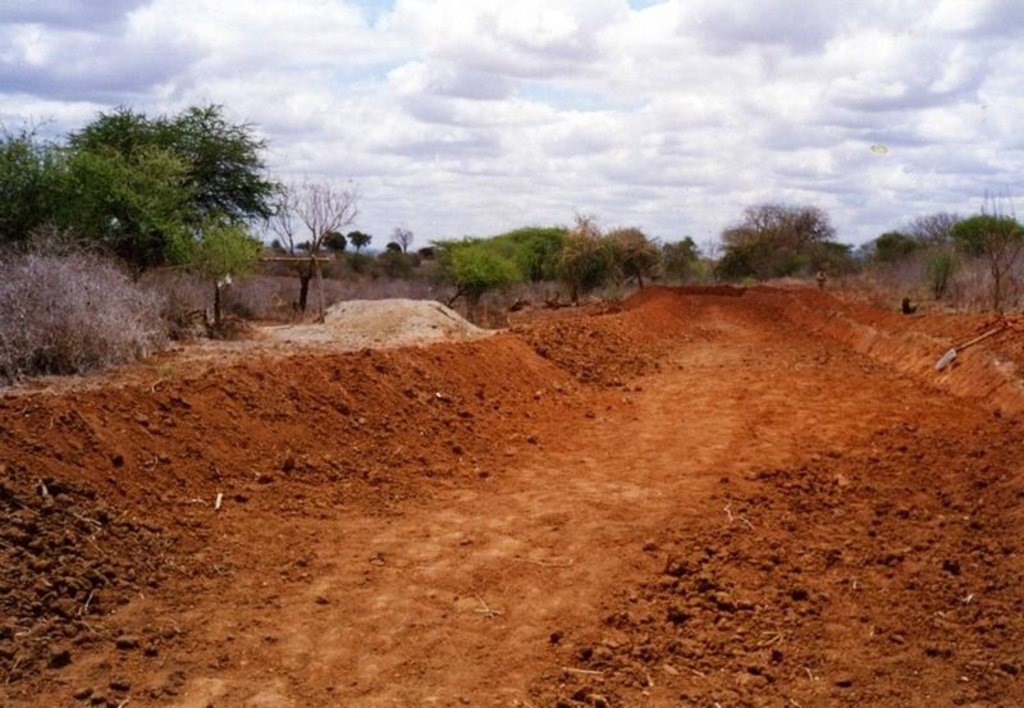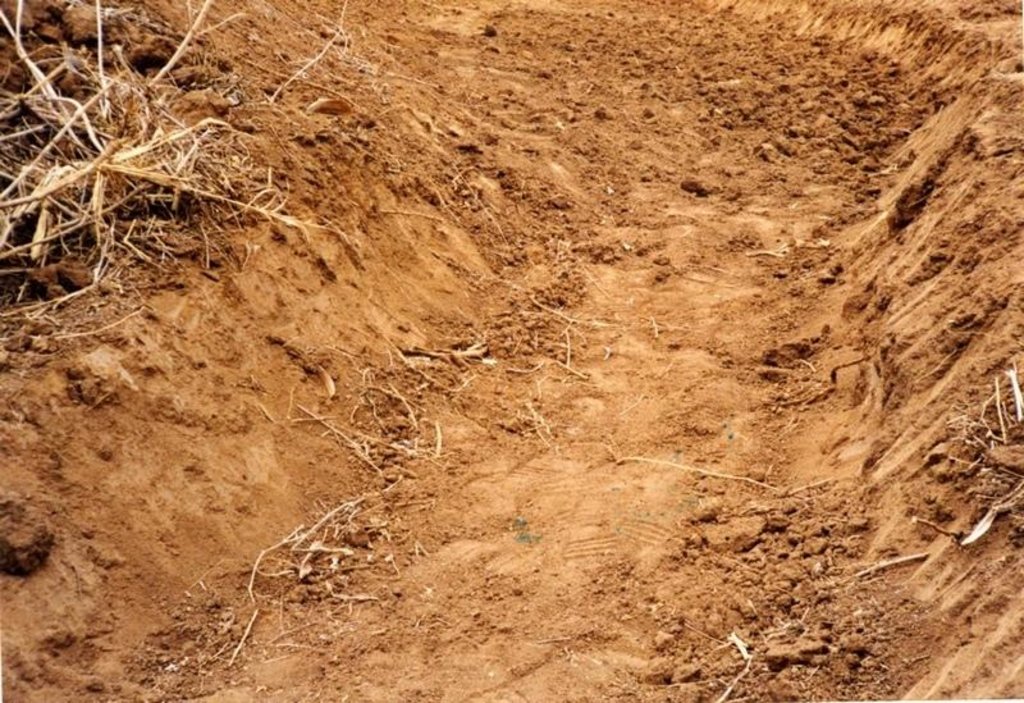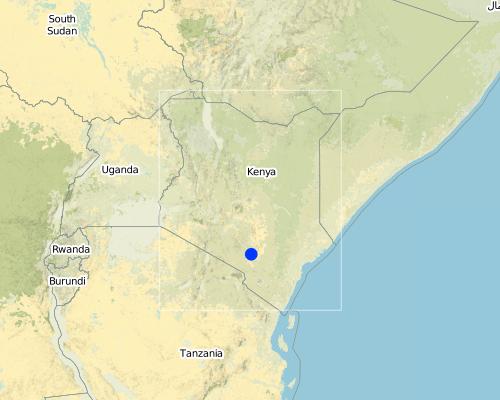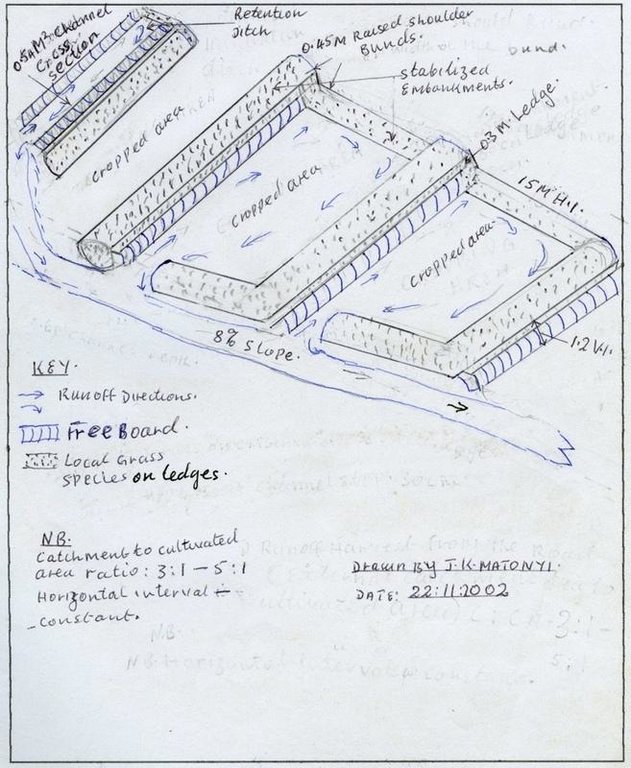Water harvest [Quênia]
- Criação:
- Atualização:
- Compilador/a: Kithinji Mutunga
- Editor: –
- Revisor: David Streiff
Kunasa maji ya muua yanuyobubugika na kuyuelekeza shambani kwa uzakshaji-Alex R.Adual RSCU/SIDA1996
technologies_1097 - Quênia
Veja as seções
Expandir tudo Recolher tudo1. Informação geral
1.2 Detalhes do contato das pessoas capacitadas e instituições envolvidas na avaliação e documentação da tecnologia
Pessoa(s) capacitada(s)
Especialista em GST:
Mutisya Peter Maithya
Daleo's office P.O.Box 42 Makueni Kenya
Quênia
Especialista em GST:
Ndengele Michael
Daleo's office P.O.Box 42 Makueni Kenya
Quênia
Especialista em GST:
Nguluu Lucas Makau
Daleo's office P.O.Box 42 Makueni Kenya
Quênia
Especialista em GST:
Especialista em GST:
Especialista em GST:
Adunal Alex R.
RELMA/SIDA
Lcraf house P.O.Box 63403 Nairobi, Kenya
Nome da(s) instituição(ões) que facilitou(ram) a documentação/ avaliação da Tecnologia (se relevante)
Ministry of Agriculture and Livestock Development of Kenya (MoA) - Quênia1.3 Condições em relação ao uso da informação documentada através de WOCAT
Quando os dados foram compilados (no campo)?
21/04/2003
O/a compilador/a e a(s) pessoa(s) capacitada(s) aceitam as condições relativas ao uso de dados documentados através da WOCAT:
Sim
2. Descrição da tecnologia de GST
2.1 Descrição curta da tecnologia
Definição da tecnologia:
Water harvest for agricultural production in Asals
2.2 Descrição detalhada da tecnologia
Descrição:
Water harvest enhances extra moisture and reduces risk of crop failure. It can either be external or internal. The activities also reduce runoff/overland flow and soil loss.
Manure and fertilizer improve soil water holding capacity and soil properties.
Appropriate tillage for improvement of infiltration rate of the soil.
2.3 Fotos da tecnologia
2.5 País/região/locais onde a tecnologia foi aplicada e que estão cobertos nesta avaliação
País:
Quênia
Região/Estado/Província:
Eastern
Especificação adicional de localização:
KiMuiki, Kitise, Mburo, Kwa Kauisi
Map
×2.6 Data da implementação
Caso o ano exato seja desconhecido, indique a data aproximada:
- menos de 10 anos atrás (recentemente)
2.7 Introdução da tecnologia
Especifique como a tecnologia foi introduzida:
- através de projetos/intervenções externas
Comentários (tipos de projeto, etc.):
ministry of agriculture and rural development, soil and water conservation branch Nairobi, Kenya
3. Classificação da tecnologia de GST
3.1 Principal/principais finalidade(s) da tecnologia
- Reduz, previne, recupera a degradação do solo
3.2 Tipo(s) atualizado(s) de uso da terra onde a tecnologia foi aplicada

Terra de cultivo
- Cultura anual
Principais plantações (colheitas para venda e consumo próprio):
Major food crop: Maize
Other: C.peas

Misto (plantação, pastagem, árvores) inclusive agrofloresta
- Agrossilvipecuária
Principais produtos/serviços:
Major cash crop CT: fruits
Selective felling of (semi-) natural forests for fuelwood purpose
Clear felling of (semi-)natural forests for agricultural production
Forest also for fruits and nuts
Comentários:
Major land use problems (compiler’s opinion): Topsoil losses, creation of hardban, soil surface crusting and fertility decline are major problems in areas without SWC.
Major land use problems (land users’ perception): Yield decline and poor quality produce are problems in areas without SWC.
Semi-nomadism / pastoralism: mixed land use type
Mixed: (eg agro-pastoralism, silvo-pastoralism): practiced by few
Other grazingland: semi-intensive grazing: semi-intensive grazing
Grazingland comments: Area closure can not be substituted, stall feeding materials not available. The family leader owns the stock but could fail to meet family needs if the system is not commercialized.
Selective felling of (semi-) natural forests: fuelwood purpose
Clear felling of (semi-)natural forests: for agricultural production
Problems / comments regarding forest use: Some uncontrolled grazing/browsing rather critical tp forest establoshment. Gapping can last long due to rainfall long intervals
Forest products and services: fuelwood, fruits and nuts
Type of cropping system and major crops comments: maize as major crop, followed by tubbers and legumes.
Type of grazing system comments: Area closure can not be substituted, stall feeding materials not available. The family leader owns the stock but could fail to meet family needs if the system is not commercialized.
Constraints of astructure network (roads, railways, pipe lines, power lines): roadside runoff enhances runoff Farming. Isolated trees preserved by traders in Mkt-centres
3.3 Mais informações sobre o uso da terra
Abastecimento de água para a terra na qual a tecnologia é aplicada:
- Precipitação natural
Número de estações de cultivo por ano:
- 2
Especifique:
Longest growing period in days: 106 Longest growing period from month to month: Mar - Jun Second longest growing period in days: 71 Second longest growing period from month to month: Oct - Dec
3.4 Grupo de GST ao qual pertence a tecnologia
- Coleta de água
3.5 Difusão da tecnologia
Comentários:
Total area covered by the SLM Technology is 45 m2.
Target-area 485 km^2 inhabited by 6550 farm families and population dynamic 46075.
3.6 Medidas de GST contendo a tecnologia

Medidas agronômicas

Medidas vegetativas
- V2: gramíneas e plantas herbáceas perenes

Medidas estruturais
- S3: Valas graduadas, canais, vias navegáveis
Comentários:
Main measures: structural measures
Secondary measures: agronomic measures, vegetative measures
Type of agronomic measures: relay cropping, manure / compost / residues, breaking compacted topsoil
Type of vegetative measures: aligned: -contour, scattered / dispersed, in blocks
3.7 Principais tipos de degradação da terra abordados pela tecnologia

Erosão do solo pela água
- Wt: Perda do solo superficial/erosão de superfície

Deteriorização química do solo
- Cn: declínio de fertilidade e teor reduzido de matéria orgânica (não causado pela erosão)

Deteriorização física do solo
- Pk: quebra e ressecamento
- Pi: selagem do solo
Comentários:
Main type of degradation addressed: Pk: sealing and crusting
Secondary types of degradation addressed: Wt: loss of topsoil / surface erosion, Cn: fertility decline and reduced organic matter content
3.8 Redução, prevenção ou recuperação da degradação do solo
Especifique o objetivo da tecnologia em relação a degradação da terra:
- Prevenir degradação do solo
Comentários:
Secondary goals: mitigation / reduction of land degradation, rehabilitation / reclamation of denuded land
4. Especificações técnicas, implementação de atividades, entradas e custos
4.1 Desenho técnico da tecnologia
4.2 Especificações técnicas/ explicações do desenho técnico
technical drawing catchment to cultural area ratio: 3:1 - 5:1 Horizontal interval constant
Makueni district
Date: 22.11.2002
Technical knowledge required for field staff / advisors: moderate
Technical knowledge required for land users: high
Main technical functions: water harvesting / increase water supply
Secondary technical functions: increase / maintain water stored in soil, increase in soil fertility
Relay cropping
Material/ species: improved mango trees
Quantity/ density: 124
Remarks: 9 m^2
Manure / compost / residues
Material/ species: FYM/compost
Quantity/ density: 12.5 t/ha
Breaking compacted topsoil
Remarks: appropriate tillage
Aligned: -contour
Vegetative material: G : grass
Vertical interval between rows / strips / blocks (m): 1.2
Spacing between rows / strips / blocks (m): 0.6x0.3
Vertical interval within rows / strips / blocks (m): 15
Width within rows / strips / blocks (m): 1.5
Scattered / dispersed
Vegetative material: T : trees / shrubs
Number of plants per (ha): 40
In blocks
Vegetative material: T : trees / shrubs
Number of plants per (ha): 124
Vertical interval between rows / strips / blocks (m): 9
Spacing between rows / strips / blocks (m): 9x9
Vertical interval within rows / strips / blocks (m): 9
Trees/ shrubs species: Cacia scamea, Accacia albida
Fruit trees / shrubs species: mango, citrus, pawpaw
Grass species: ceuchrus cuharis, erayroster superba
Slope (which determines the spacing indicated above): 8.00%
If the original slope has changed as a result of the Technology, the slope today is (see figure below): 0.00%
Gradient along the rows / strips: 0.20%
Retention/infiltration ditch/pit, sediment/sand trap
Vertical interval between structures (m): 1.2
Depth of ditches/pits/dams (m): 0.6
Width of ditches/pits/dams (m): 1.2
Length of ditches/pits/dams (m): 100
Height of bunds/banks/others (m): 0.45
Width of bunds/banks/others (m): 1.5
Terrace: bench level
Vertical interval between structures (m): 1.2
Spacing between structures (m): 15
Depth of ditches/pits/dams (m): 0.6
Length of ditches/pits/dams (m): 100
Height of bunds/banks/others (m): 0.45
Construction material (earth): earth moving for SWC embankment construction
Slope (which determines the spacing indicated above): 8%
Lateral gradient along the structure: 0.2%
Vegetation is used for stabilisation of structures.
Change of land use type: stock holding capacity of land
4.3 Informação geral em relação ao cálculo de entradas e custos
Especifique a moeda utilizada para os cálculos de custo:
- Dólares norte-americanos
Indique a média salarial da mão-de-obra contratada por dia:
1.92
4.4 Atividades de implantação
| Atividade | Tipo de medida | Periodicidade | |
|---|---|---|---|
| 1. | grass planting on embankments | Vegetativo | after onset of rain |
| 2. | fruits seedling transplanting | Vegetativo | october rain |
| 3. | dispersed tree seedlings transplanting | Vegetativo | october rain |
| 4. | retention/infiltration ditches | Estrutural | after crop harvest |
| 5. | Bench terraces | Estrutural | after crop harvest |
| 6. | external water harvest channels | Estrutural | before raining season |
| 7. | structure stabilization | Estrutural | onset of rain |
| 8. | manure/fertilizer application | Estrutural | after crop harvest |
| 9. | Bush clearing | Gestão | after grazing |
| 10. | reseeding/grass planting in bare parches | Gestão | dry season |
| 11. | fodder establishment | Gestão | rainy season |
| 12. | removal of unwanted shrubs | Gestão | following rotational sequence |
4.5 Custos e entradas necessárias para a implantação
| Especifique a entrada | Unidade | Quantidade | Custos por unidade | Custos totais por entrada | % dos custos arcados pelos usuários da terra | |
|---|---|---|---|---|---|---|
| Mão-de-obra | Labour | ha | 1,0 | 296,0 | 296,0 | 100,0 |
| Equipamento | Machine use | ha | 1,0 | 32,5 | 32,5 | 100,0 |
| Equipamento | Animal traction | ha | 1,0 | 72,3 | 72,3 | 100,0 |
| Equipamento | Tools | ha | 1,0 | 385,0 | 385,0 | 100,0 |
| Material vegetal | Seeds | ha | 1,0 | 76,3 | 76,3 | 100,0 |
| Material vegetal | Seedligs | ha | 1,0 | 79,5 | 79,5 | 100,0 |
| Fertilizantes e biocidas | Fertilizer | ha | 1,0 | 58,0 | 58,0 | 100,0 |
| Fertilizantes e biocidas | Biocides | ha | 1,0 | 47,4 | 47,4 | 100,0 |
| Fertilizantes e biocidas | Compost/manure | ha | 1,0 | 78,0 | 78,0 | 100,0 |
| Material de construção | Stone | ha | 1,0 | 244,0 | 244,0 | 100,0 |
| Custos totais para a implantação da tecnologia | 1369,0 | |||||
Comentários:
Duration of establishment phase: 36 month(s)
4.6 Atividades recorrentes/manutenção
| Atividade | Tipo de medida | Periodicidade/frequência | |
|---|---|---|---|
| 1. | tillaging | Agronômico | before rain / annually |
| 2. | tillaging | Agronômico | on set / seasonally |
| 3. | manure application | Agronômico | dry season / annually |
| 4. | grass cutting and gapping | Vegetativo | onset of rain /twice per season |
| 5. | prunning and trimming | Vegetativo | after every harvest /annual |
| 6. | pollading and copsing | Vegetativo | when intended /after several years |
| 7. | retention/infiltration | Estrutural | before onset of rain/seasonally |
| 8. | ditch cleaning | Estrutural | before onset of rain/anually |
| 9. | Bench terraces repairing | Estrutural | before onset of rain/when necessary |
| 10. | Water channel cleaning/repairing | Estrutural | dry period/seasonally |
| 11. | grass cutting for stall feedinf | Gestão | rainy season / at maturity stage |
| 12. | gapping | Gestão | rainy season / seasonally |
4.7 Custos e entradas necessárias pata a manutenção/atividades recorrentes (por ano)
| Especifique a entrada | Unidade | Quantidade | Custos por unidade | Custos totais por entrada | % dos custos arcados pelos usuários da terra | |
|---|---|---|---|---|---|---|
| Mão-de-obra | Labour | ha | 1,0 | 98,0 | 98,0 | 100,0 |
| Equipamento | Animal traction | ha | 1,0 | 72,3 | 72,3 | 100,0 |
| Material vegetal | Seeds | ha | 1,0 | 67,3 | 67,3 | 100,0 |
| Material vegetal | Seedlings | ha | 1,0 | 55,7 | 55,7 | 100,0 |
| Fertilizantes e biocidas | Fertilizer | ha | 1,0 | 44,2 | 44,2 | 100,0 |
| Fertilizantes e biocidas | Biocides | ha | 1,0 | 21,5 | 21,5 | 100,0 |
| Material de construção | Earth | ha | 1,0 | 244,0 | 244,0 | 100,0 |
| Custos totais para a manutenção da tecnologia | 603,0 | |||||
Comentários:
Machinery/ tools: oxplough, oxcart, hoe, sprayer, shovel, wheelbarrow
The above costs were calculated in cost per qm
4.8 Fatores mais importantes que afetam os custos
Descreva os fatores mais determinantes que afetam os custos:
Factors affecting the costs include hard ground at SWC peak period, labour, slope, catchment area, channel size and source of income
5. Ambiente natural e humano
5.1 Clima
Precipitação pluviométrica anual
- <250 mm
- 251-500 mm
- 501-750 mm
- 751-1.000 mm
- 1.001-1.500 mm
- 1.501-2.000 mm
- 2.001-3.000 mm
- 3.001-4.000 mm
- > 4.000 mm
Especifique a média pluviométrica anual em mm (se conhecida):
350,00
Zona agroclimática
- Semiárido
- Árido
semi-arid: LGP-70-180
arid: LGP-60-120
5.2 Topografia
Declividade média:
- Plano (0-2%)
- Suave ondulado (3-5%)
- Ondulado (6-10%)
- Moderadamente ondulado (11-15%)
- Forte ondulado (16-30%)
- Montanhoso (31-60%)
- Escarpado (>60%)
Formas de relevo:
- Planalto/planície
- Cumes
- Encosta de serra
- Encosta de morro
- Sopés
- Fundos de vale
Zona de altitude:
- 0-100 m s.n.m.
- 101-500 m s.n.m.
- 501-1.000 m s.n.m.
- 1.001-1.500 m s.n.m.
- 1.501-2.000 m s.n.m.
- 2.001-2.500 m s.n.m.
- 2.501-3.000 m s.n.m.
- 3.001-4.000 m s.n.m.
- > 4.000 m s.n.m.
Comentários e outras especificações sobre a topografia:
Altitudinal zone: about 1000 m a.s.l. average
Landforms: Footslopes 8-16% slope and valley floors 2-8% slope
Slopes on average: Moderate = 6.5 % and rolling = 12 %
5.3 Solos
Profundidade do solo em média:
- Muito raso (0-20 cm)
- Raso (21-50 cm)
- Moderadamente profundo (51-80 cm)
- Profundo (81-120 cm)
- Muito profundo (>120 cm)
Textura do solo (solo superficial):
- Grosso/fino (arenoso)
- Médio (limoso, siltoso)
Matéria orgânica do solo superficial:
- Médio (1-3%)
- Baixo (<1%)
Caso disponível anexe a descrição completa do solo ou especifique as informações disponíveis, p. ex. tipo de solo, PH/acidez do solo, nitrogênio, capacidade de troca catiônica, salinidade, etc.
Soil depth on average: shallow = 35 cm average and moderately deep = 65 cm average
Soil texture: Coarse/light = degradable/erodable and medium is common in the division
Soil fertility is medium in newly opened lands but fertility depletes quickly and is therefore also low.
Topsoil organic matter is medium on newly opened land and low after several years of cultivation.
Soil drainage / infiltration is medium with regular improvement, but there is also top soil crusting and therefore drainage becomes poor,
Soil water storage capacity is low during long duration of rainfall intervals and medium (effectiveness not realistic).
5.6 Características dos usuários da terra que utilizam a tecnologia
Orientação de mercado do sistema de produção:
- Misto (subsistência/comercial)
Rendimento não agrícola:
- 10-50% de toda renda
Nível relativo de riqueza:
- Pobre
- Média
Nível de mecanização:
- Trabalho manual
- Tração animal
Indique outras características relevantes dos usuários da terra:
Population density: 50-100 persons/km2
Annual population growth: 3% - 4%
20% of the land users are rich and own 20% of the land (prestige).
35% of the land users are average wealthy and own 30% of the land (improved living standard).
25% of the land users are poor and own 20% of the land (for subsistance).
Off-farm income specification: Most of youth seek for off-farm employment. Others due to lack of employment engage on trading as small holders.
Level of mechanization: Around 75 % use animal traction and manual labour is especially used for weeding
5.7 Média da área de terra própria ou arrendada por usuários da terra que utilizam a tecnologia
- < 0,5 ha
- 0,5-1 ha
- 1-2 ha
- 2-5 ha
- 5-15 ha
- 15-50 ha
- 50-100 ha
- 100-500 ha
- 500-1.000 ha
- 1.000-10.000 ha
- > 10.000 ha
Comentários:
Average area of land owned or leased by land users applying the Technology: Also 0.5-1 ha
5.8 Propriedade de terra, direitos de uso da terra e de uso da água
Propriedade da terra:
- Indivíduo, não intitulado
- Indivíduo, intitulado
Direitos do uso da terra:
- Indivíduo
6. Impactos e declarações finais
6.1 Impactos no local mostrados pela tecnologia
Impactos socioeconômicos
Produção
Produção agrícola
Comentários/especificar:
Extra output 50%
Área de produção
Comentários/especificar:
given area reduced by 14%
Renda e custos
Rendimento agrícola
Comentários/especificar:
Extra income 27.5%
Carga de trabalho
Comentários/especificar:
requires high labour costs
Impactos socioculturais
Instituições comunitárias
Comentários/especificar:
in capacity building
Conhecimento de GST/ degradação da terra
Comentários/especificar:
to land user
Impactos ecológicos
Ciclo hídrico/escoamento
Escoamento superficial
Quantidade anterior à GST:
32
Quantidade posterior à GST:
14
Drenagem de excesso de água
Comentários/especificar:
risking occasion
Solo
Umidade do solo
Comentários/especificar:
external WH.
Perda de solo
Quantidade anterior à GST:
20
Quantidade posterior à GST:
10
Comentários/especificar:
WH combination
6.2 Impactos externos mostrados pela tecnologia
Caudal confiável e estável em período seco
Comentários/especificar:
irrigation potential reduced
Cheias de jusante
Comentários/especificar:
rainfall runoff trapped
Sedimentação a jusante
Comentários/especificar:
silt retained on cropland
6.4 Análise do custo-benefício
Como os benefícios se comparam aos custos de implantação (do ponto de vista dos usuários da terra)?
Retornos a longo prazo:
positivo
Como os benefícios se comparam aos custos recorrentes/de manutenção(do ponto de vista dos usuários da terra)?
Retornos a curto prazo:
muito positivo
6.5 Adoção da tecnologia
- 1-10%
Se disponível, determine a quantidade (número de unidades familiares e/ou área abordada):
630 household covered an area of 9%
Entre todos aqueles que adotaram a tecnologia, quantos adotaram espontaneamente, ou seja, sem receber nenhum incentivo material/pagamentos?
- 90-100%
Comentários:
630 land user families have adopted the Technology without any external material support
Comments on spontaneous adoption: estimates
There is a moderate trend towards spontaneous adoption of the Technology
Comments on adoption trend: Pressure on daily personal needs. No other sources of income yet the rainfall is not reliable in ASALS.
6.7 Pontos fortes/vantagens/oportunidades da tecnologia
| Pontos fortes/vantagens/oportunidades na visão do usuário da terra |
|---|
|
induces the technique of implementation How can they be sustained / enhanced? land users be aquidance with the technology and its importance. |
|
land users acquires more grass for stall feeding. How can they be sustained / enhanced? introduction of intensive grazing system. |
|
reduces floods of heavy storms downsteram. How can they be sustained / enhanced? Proper tillage to curb soil crusting and hardban. |
| Pontos fortes/vantagens/oportunidades na visão do/a compilador/a ou de outra pessoa capacitada |
|---|
|
water harvest increases farm production and reduces risks of crop failure. How can they be sustained / enhanced? To stabilize SWC structure embankments, desilt channels and retention ditches. |
|
Improvement in infiltration rate and moisture holding capacity. How can they be sustained / enhanced? Use of manure, organic matter, inorganic fertlizer and appropriate tillage. |
|
Reduces soil, fertility, runoff and overland flow losses How can they be sustained / enhanced? Maximum adaptability of the SWC technology to ustain high production level. |
|
Enhanced vegetative cover for moisture retention. How can they be sustained / enhanced? Intercropping, mulching and repairing where needed. |
|
Reduces erosion by wind and other land degradation. How can they be sustained / enhanced? Appropriate stocking rate andd replanting trees and grass. |
6.8 Pontos fracos, desvantagens/riscos da tecnologia e formas de superá-los
| Pontos fracos/desvantagens/riscos na visão do usuário da terra | Como eles podem ser superados? |
|---|---|
| consumes a lot of time to implement the technology | the land user awareness of the importance of the activity. |
| Technology area resists a direct grazing | to mitiate stall feeding |
| the technology design is beyond the farmers knowledge. | continuous interaction with SWC specialists. |
| Pontos fracos/vantagens/riscos na visão do/a compilador/a ou de outra pessoa capacitada | Como eles podem ser superados? |
|---|---|
| Land area reduced by SWC structures constructed. | Use of certified seeds, manure and fertilizer. |
| soil fertility is interfered with. | more manure and organic matter use. |
| High labour cost requirement to implement the technology. | Introduced source of smooth loan and policy for ASALS. |
| Risk of water logging where soil drainage is unaimable. | acquired knowledge of different soil types and applicable technology and system. |
| cost-benefit return can last long to be realized. | to maintain record for both, implementing cost and income from the given area (SWC area) |
7. Referências e links
7.2 Referências às publicações disponíveis
Título, autor, ano, ISBN:
SWC manual for Kenya by D:B: Thomas. 1997.
Disponível de onde? Custos?
Mard Kenya, free
Título, autor, ano, ISBN:
SWC technology Dev. in ASAL by Kithinji Mutunga
Disponível de onde? Custos?
SWC branch, free
Título, autor, ano, ISBN:
SC in Kenya, Carl G.Wenner. 1984.
Disponível de onde? Custos?
Aici, free
Título, autor, ano, ISBN:
ony superb DXE-180 video
Disponível de onde? Custos?
Mard Kenya, free
Título, autor, ano, ISBN:
The sun will still rise
Disponível de onde? Custos?
Mard Kenya, free
Título, autor, ano, ISBN:
Run off a friend or a foe
Disponível de onde? Custos?
Mard Kenya, free
Links e módulos
Expandir tudo Recolher tudoLinks
Não há links
Módulos
Não há módulos


